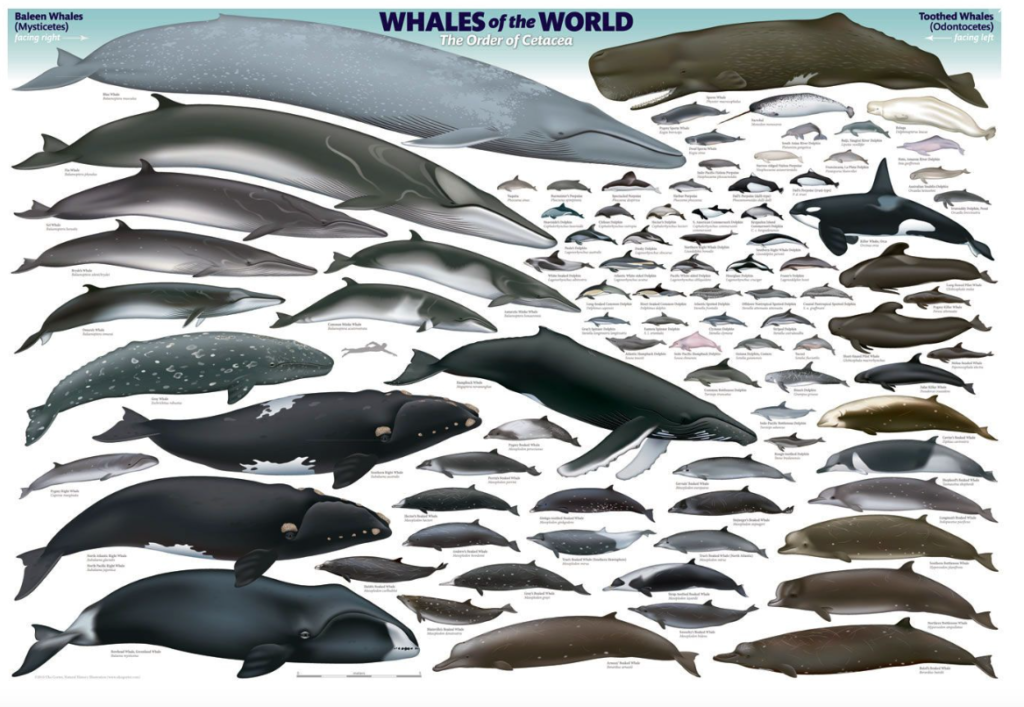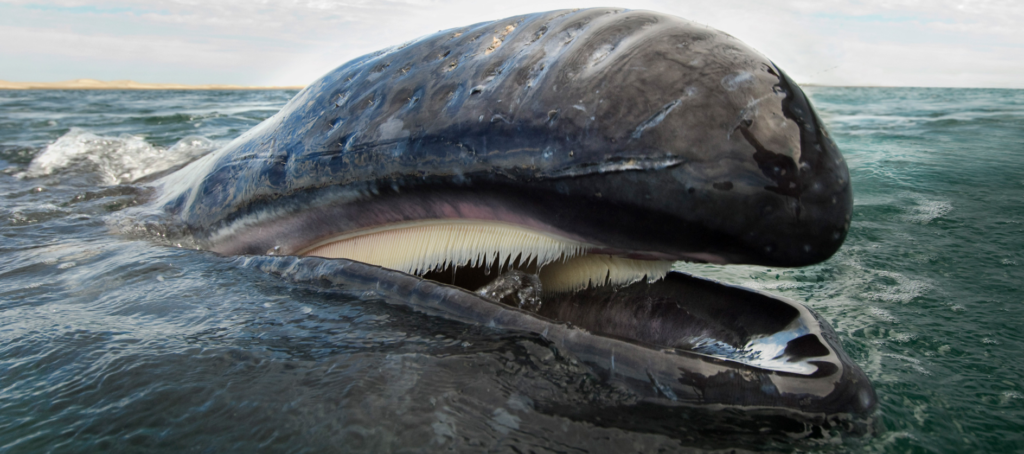The Mystical Beast

Cetaceans are a big family of massive mammals that act like fish. All whales, porpoises and dolphins are in this class. Balaenoptera musculus is identified in the cetacean family by their baleen, which is a fur-looking substance made of keratin, a protein.
Cetaceans are mammals who live in the ocean. Only the cetaceans live their whole life in the ocean; seals, sea lions and elephant seals all have to haul up on shore from time to time, to mate and sleep, and get a tan. Mysticeti and odesetie are the two types of cetaceans. The odontoceti family has the dolphins, whales, and porpoises that have teeth, but the mysiceti family, which is mostly whales, have baleen which causes them to eat with a filter feeding process.
Baleanoptiridae: these are whales with baleen, but also with expansive mouth flaps; these whales are mostly mentioned as rorquals, which is a Norwegian word meaning furrow whale. You know how when you fold a piece of clothing it becomes smaller, and you can place it on a shelf? Think about that with baleen whales: their furrowed throats can expand dramatically. Furrows and keratin are two very different things: furrows are like a bag that takes a big gulp of water, but keratin is baleen that filters. Baleen is made out of keratin, which is also what a fingernail is made out of. Baleen could look like a horse’s tail or even a strainer that is vertical. So, these whales have throat pleats on the bottom of the mouth which are used for catching a lot of food at once.

The balaenopteridae is split into two batches: the balaenopteridae, which has the genus balaenoptera; and the megapterinae, confining the genus megaptera and it also has the lonely species megaptera novaeangliae, which is frequently known as the humpback whale.

For a way to relate the humpback to the Albanian language, see the Indo-European Language tree (which is massive)… there is one little twig coming off of it which unconnected to any other language: Albanian language: sorta like a humpback!

This lone whale, separated from the others must have a reason for being separated, right? Yep, it is their pecs! Now, I know you’re thinking about that gym rat who has massive pecs (and canckles) but get out of the gym obsession – we’re talking animals here. The humpback’s pecs are huge and long – and just like the sperm whale, whose head is one-third of its body length, the humpback’s pecs are also one third of its length!

The genus balaenoptera contains eight species (the eighth species, balaenoptera omurai, once thought to be a pygmy form of balaenoptera brydei (Bryde’s whale), has recently been proposed). It also contains the minke whale and Antarctic minke whale, fin whale, sei whale, and Bryde’s whale.
Instead of hair, which they don’t have much of, they have blubber to heat themselves up when they are in the colder parts of the ocean. The front limbs that you can see in terrestrial mammals are, for the whales, fins.

Most of the baleen whale population have hair follicles attached to them. Some of those baleen whales for example the Humpback whale have hair that you can see with your own eyes though it might be a little tough because each tubercle on the head only has a single hair on them. If the whale is brave enough to get close, you might be able to get a glimpse of one. Now thinking that their head is massive you might be wondering oh they probably have thousands of hairs but in real life they only have 30-100 depending on what kind of whale.
Now that you are a classified genius on whales you will now feast your eyes on the greatest part of the entire essay. The information you will learn in a couple of minutes will demolish your idea of the blue whale and rebuild it brick by brick.

The blue whale diet
The blue whale is the biggest animal in the world but what they eat can be very interesting! The blue whale favorite food is krill, but they are actually very small, and that is why they can eat 40,000,000 every day (yes that is 40 million). The reason they eat so much is because one, they are biggest animal on the planet but two, they need the energy to swim which you could imagine takes up A LOT of energy. The big blues are most likely found in large schools of krill but other than that they are pretty rare rarely spotted. They can chomp three to four tons of food per day: that’s 8,000 pounds! Blue whales gulp a big mouthful of water and krill and they use their baleen plates to filter the krill and water so it’s only krill, and then they feast on the krill. The blue whales are mammals so the moms breastfeed their young. The young of a blue whale is called a calf. Calves drink 380 liters of milk a day within 7 months of being alive – imagine drinking 100 gallons of milk a day! A blue whale calf gains 200 pounds a day just from milk. The calf drinks the milk by going under water and nudging the mom’s tummy and drinking and coming up for air and drinking and it keeps going until the calf is full. The blue whale also eats copepod which is a miniature animal that has whiskers on their head.

Painting by Larry Foster
The blue whale’s stats
The blue whale has so many stats that it is really hard to count. The blue whale is huge, and its length surpasses the length of two school buses. Being so big you’d think it was slow, but it can actually swim as fast as 30 knots (34.5 mph). Did you know that the blue whale almost went extinct! Recent estimates put the population at below 25,000, but this is better than what it was in the year 1970, when it is estimated that the population shrank to just 600. Babies: the blue whale babies can weigh 6,000 pounds and 25 feet. The blue whale calf can be the size of an orca. The adult blue whales can be 70-90 feet long and they usually live to about 80-90 years old. The largest blue whale ever recorded was 109 feet long and it weighed about 200 tons. The oldest blue whale is 109 years old, that’s almost as old as the oldest person ever. The calves gain about 200 pounds a day. The blue whale is a big animal, and they can hold the weight of 150 tons which is 300,000 pounds.
Predators and threats
The ginormous blue whale is very large but did you know they are ‘frady cats? The blue whale’s main predator is the orca also known as the killer whale. One reason that the orca is the biggest predator of the blue whale because they are mean, but they are also one of the only known predators of the blue whale. Now you may be thinking what’s the other predator of the blue whale and it is actually human beings. The humans are predators because they used to (it’s banned now) go whaling which is when they catch and kill whales for their large amount of blubber and rich oil.
The blue whale has three different main threats. One of which is vessel strikes, which is when a boat or object collides with an animal. Vessel strikes usually end in death for the animal because they can bleed out and no one is there to help them. Another threat is oil and toxic waste. When oil leaks out of the machines and a blue whale is near it is really toxic and poisonous to the blue whale and can sometimes kill them. Also, the plastic is really bad for them because it can get stuck to the blue whale or they swallow it by accident and they can choke or not be able to move. The last reason is entanglement of fishing gear. Fishers can sometimes get snapped off which means their fishing line breaks and when that happens it can get tangled in a lot of things including a blue whale which is really bad because it is like it you have a hook stuck in your back or throat and you can’t get it out and it is just there and hurts so much!
The baleen
The big blue whale has an extraordinary way of eating their food, remember? It is called, can you guess it? … baleen! The blue whale has 500-800 baleen plates attached to the upper jaw to help separate the water and the krill. It works like a strainer; if you dump all the pasta in and then the water goes out and all you have left is the pasta. The blue whale version is you take a big mouthful of water and the baleen plates filter it out and all you’re left with is krill. Each of the baleen plates is made out of a type of protein called keratin which is the same material that’s in your hair and fingernails. The blue whale keeps repeating the eating process and that is why they eat almost three to four tons of krill every single day. The baleen can filter 50-100 tons of water and krill daily.
You now know everything there is to know about a blue whale and can forever be a person with a big brain. Also you will hopefully see at least one blue whale in your lifetime. Now even that you maybe don’t live near an ocean or you never travel you can see the wonderful pictures of them and get a glimpse of what they actually look like.

Glenn Olson, 1985

